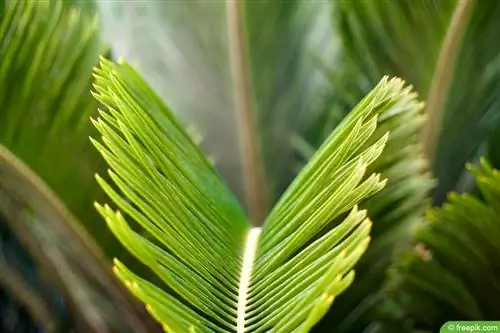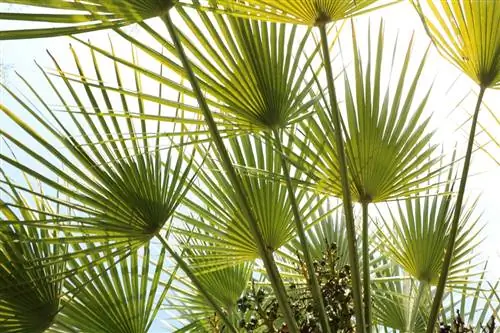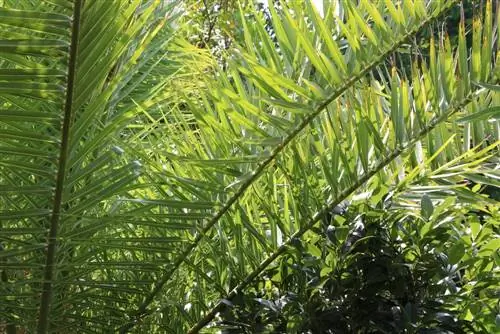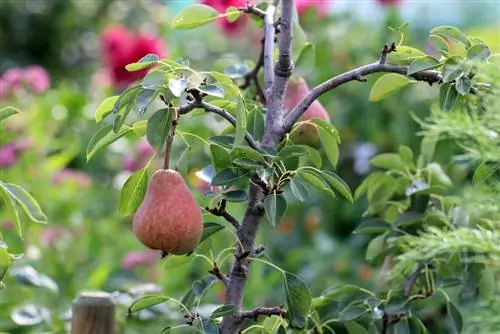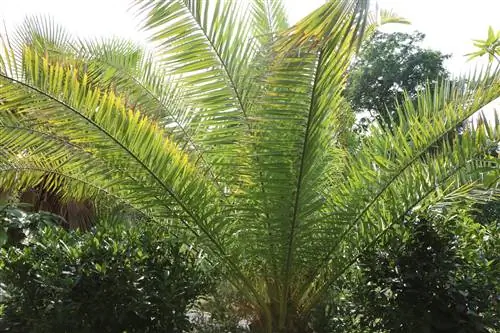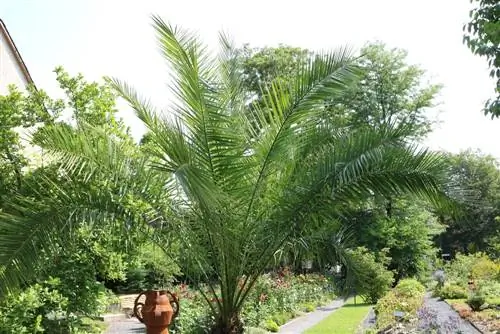- Author admin [email protected].
- Public 2023-12-17 03:39.
- Last modified 2025-01-24 12:45.
Their greatest adornment are the light green, delicate fronds, whose growth is mainly broad. It is the perfect houseplant and relatively easy to care for, even for plant newbies.
Profile
- Origin: Asia
- Plant family: Palm family (Arecaceae)
- Botanical name: Phoenix roebelenii
- German name: dwarf date palm
- Growth: in cultivation usually single-stemmed, compact
- Growth height: as a houseplant up to 100 cm
- Leaves: light green, narrow, overhanging feathery fronds
- Flower: very rare when kept indoors, white and inconspicuous
- Toxicity: not poisonous
Site conditions
Since this palm is not hardy, it is usually cultivated as a houseplant. Phoenix roebelenii should be given a partially shaded to sunny spot. Sufficient light must be ensured, especially in the apartment. Five hours of sun per day is optimal. A location in the blazing sun, especially during midday, is not recommended. She feels most comfortable at temperatures around 20 degrees. These should not be significantly undercut. In summer, the dwarf date palm is grateful for a location outdoors, but then in partial shade if possible.
Tip:
If the site conditions are unfavorable, damage can occur to this palm tree that is difficult or impossible to correct.
Soil texture
When it comes to substrate, the dwarf date palm (Phoenix roebelenii) appreciates compost-based soil mixed with gravel, expanded clay, lava grit or sharp sand. It should have high permeability and be nutrient-rich with a neutral pH value. It is best to mix one third of coarse proportions with two thirds of compost soil. What is not suitable at all is pure peat or humus soil. Both substrates have the disadvantage that they collapse, which hinders adequate drainage and aeration of the roots.
Tip:
The pot for the palm tree should be tall rather than wide, as its roots mainly go deep.
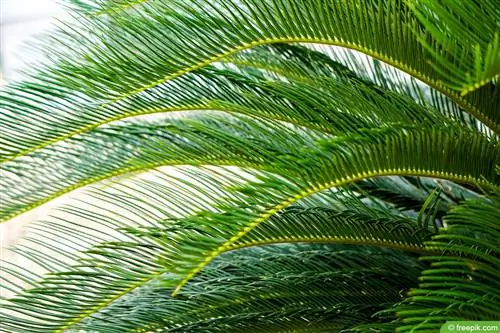
Watering according to needs
Due to their natural location near water, the water requirement of the dwarf date palm is comparatively high. In indoor cultivation, the amount and frequency of watering depend heavily on the size of the pot and plant. A uniform moisture content of the substrate is essential for this plant. However, waterlogging should be avoided.
- best to water thoroughly
- Substrate should be well moistened
- Allow the soil to dry thoroughly before each watering
- should never dry out completely
- water again after one to three days outdoors
- Examples that are permanently in the apartment, after about a week
- depending on prevailing temperatures
In addition to watering via the substrate, it is also important to ensure that the air humidity is sufficiently high. This should be at least 60 percent. To achieve this, mist the plant regularly with lukewarm water, preferably soft water.
Tip:
In order to avoid overwatering or complete drying out of the soil, the use of water level indicators is recommended.
Fertilization
For he althy growth, the dwarf date palm needs a lot of nutrients from spring to summer. To cover the requirements, a complete fertilizer, preferably in liquid form, is administered every 14 days from April to September. The trade also offers special palm fertilizers that should be dosed and administered according to the manufacturer's instructions. The fertilizer used should contain only a little phosphorus. Over-fertilization should be avoided in any case.
Cutting measures
Palm trees are generally not cut. But as is often the case, exceptions prove the rule. The dwarf date palm (Phoenix roebelenii) can form several trunks through lateral shoots. Since the single-stemmed species is usually the most attractive, shoots that protrude from the sides can be removed early. The clippings can be used for propagation if necessary.
- otherwise just cut off the wilted leaves
- assuming they are completely wilted
- a piece of the stem should remain
- Do not prune or shorten trunks
- do not cut out any brown spots on the fronds
- Entry portals for bacteria and fungi would be created
Tip:
If the dwarf date palm becomes too big for you, you have the option of preventing or slowing down further growth by shortening the roots by a few centimeters. In the first few days afterwards, it is best to water and fertilize only moderately.
Winter properly
Overwintering should take place in a cool, bright room at temperatures of eight to twelve degrees. These can be bright hallways, cellars and garages as well as heated winter gardens or greenhouses. In darker rooms, the additional use of plant lamps is recommended. If the plant is in an unheated winter garden, a south, southeast or southwest window, this can usually be avoided.
In warmer accommodations, it is important to ensure sufficiently high humidity. Even in winter, the alternation of watering and letting it dry should be maintained. However, watering is now much more economical because the cooler temperatures during overwintering mean that the substrate dries out more slowly. There is no fertilization during this time.
Moving outdoors
At the beginning of the warm season, the dwarf date palm can go outside again. However, you should not expose them to sunlight immediately, but rather get them used to the changed conditions first. In particular, they can only tolerate direct sun after a certain period of getting used to them. If you don't give it this, you can quickly get burned on the fronds.
It's best to place them in a partially shaded spot with some sun in the morning and evening for the first week or two. Then it can be moved to a sunnier location without the blazing midday sun. From spring onwards, watering is gradually increased again so that it is back to normal level at the start of the main growth phase.
Repot regularly
Like all plants in pots and containers, this date palm also needs to be repotted regularly. This usually happens about every three to four years at the beginning of spring. At the latest when the roots emerge from the bottom of the pot or through the surface of the substrate. The new pot should be sufficiently large. The larger it is, the better the roots can develop and the more water can be held.
- new planter at least 20% larger than the old one
- especially in the depths
- with sufficient drainage holes
- Drainage made of gravel, expanded clay or similar materials on the bottom of the pot
- fill with some fresh substrate
- Carefully remove the dwarf palm from the old pot
- insert in the middle of the new pot
- just as deep as before
- Root should not be pressed or squeezed
- shorten a little if necessary
- Fill the pot with soil up to a few centimeters below the edge
- Press down the soil and water well
Propagation
There are various options to choose from for propagation
About seeds
Propagation by sowing is possible, but it takes a relatively long time, as it can take several months to three years for the first seedlings to appear. It is possible all year round.
- First soak seeds in lukewarm water
- fill small pots or growing trays with growing substrate
- Spread seeds on top, press lightly
- cover one to two centimeters with substrate
- moisten the whole thing well
- keep evenly moist until germination
- Place the cultivation containers in a bright place without direct sunlight
- at temperatures around 20 degrees
- Transplant seedlings from a size of five centimeters into sandy substrate
Using saplings
Propagation using saplings is somewhat more promising and uncomplicated. They sprout directly from the trunk of the palm tree in spring. As soon as they have formed roots, they can be separated and used for cultivation.
- Cut the sapling as close to the trunk as possible
- fill small pot with soil
- a mixture of sand and humus
- Insert cuttings in the middle
- Press the soil lightly around the sapling, water moderately
- Keep substrate evenly moist
- Avoid waterlogging and drying out
- place in a bright 20-24 degree place
- Avoid direct sunlight here too
- Humidity of 60-70 percent is optimal
Locations with warm soil are particularly good and conducive to root formation. Rooting usually occurs within three months. The young plants should not be fertilized in the first five to six months after planting.

Pests
There are various pests that can make life difficult for the dwarf date palm. However, if you recognize the danger in time, you can combat it quite successfully.
Scale insects
You can recognize them by their small brown tags. They can be combated, among other things: with a spray solution of one liter of water and 20 ml each of denatured alcohol and soft soap. As a preventive measure, you should ensure that the humidity is sufficiently high.
Spider mites
A spider mite infestation is evident in fine white webs mainly in the leaf axils. They impair growth and weaken the palm. To combat them, you can spray them dripping wet with a homemade solution made from soap and alcohol for several days in a row, including under the leaves. Specialist retailers also offer effective pesticides for combating them.
Thrips
Suction marks and dark bumps on the leaves of the dwarf date palm can indicate a thrips infestation. Since these pests like it dry, they can be easily gotten rid of by showering. The substrate should be covered beforehand. Regular spraying of the palm fronds can prevent infestation.
Damage caused by care errors
A common phenomenon on the dwarf date palm is brownish discoloration on the palm fronds. But that doesn't mean she's sick. Discoloration is usually the result of a lack of care or unfavorable location conditions.
Responsible for this can be sunburn, air that is too dry or substrate that is too dry, as well as errors in fertilization. If you get sunburned, you should change the location. If there is a lack of moisture or water, watering behavior should be corrected and the plant sprayed regularly. To avoid over-fertilization, liquid fertilizer should preferably be used and the correct dosage should be ensured.

